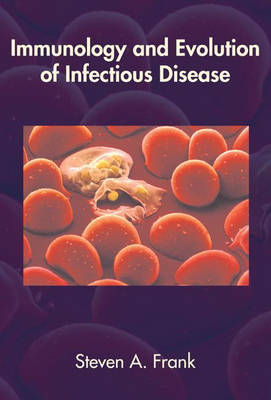
Immunology and Evolution of Infectious Disease
Princeton University Press (Verlag)
978-0-691-09594-3 (ISBN)
- Titel ist leider vergriffen;
keine Neuauflage - Artikel merken
From HIV to influenza, the battle between infectious agents and the immune system is at the heart of disease. Knowledge of how and why parasites vary to escape recognition by the immune system is central to vaccine design, the control of epidemics and our fundamental understanding of parasite ecology and evolution. This text uses an evolutionary perspective to meld the terms and findings of molecular biology, immunology, pathogen biology and population dynamics. This multidisciplinary approach offers newcomers a readable introduction while giving specialists a guide to allied subjects. Every aspect of the immune response is presented in the functional context of parasite recognition and defence - an emphasis that gives structure to a large amount of data and brings into focus the complexity of immunology. The problems that end each chapter set the challenge for future research and the text includes extensive discussion of HIV, influenza, foot-and-mouth disease and many other pathogens.
Steven A. Frank is Professor of Evolutionary Biology at the University of California, Irvine, and the author of "Foundations of Social Evolution" (Princeton).
Acknowledgments xi 1. Introduction 3 PART I: BACKGROUND 2. Vertebrate Immunity 13 2.1 Nonspecific Immunity 14 2.2 Specific Immunity: Antigens and Epitopes 15 2.3 B Cells and Antibodies 16 2.4 T Cells and MHC 19 2.5 Summary 20 3. Benefits of Antigenic Variation 22 3.1 Extend Length of Infection 23 3.2 Infect Hosts with Prior Exposure 24 3.3 Infect Hosts with Genetically Variable Resistance 26 3.4 Vary Attachment Characters 26 3.5 Antigenic Interference 28 3.6 Problems for Future Research 29 PART II: MOLECULAR PROCESSES 4. Specificity and Cross-Reactivity 33 4.1 Antigens and Antibody Epitopes 35 4.2 Antibody Paratopes 36 4.3 Antibody Affinity Maturation 38 4.4 Natural Antibodies-Low-Affinity Binding to Diverse Antigens 39 4.5 Affinity versus Specificity 40 4.6 Cross-Reaction of Polyclonal Antibodies to Divergent Antigens 42 4.7 T Cell Epitopes 44 4.8 Every Host Differs 52 4.9 Problems for Future Research 54 5. Generative Mechanisms 57 5.1 Mutation and Hypermutation 58 5.2 Stochastic Switching between Archival Copies 61 5.3 New Variants by Intragenomic Recombination 66 5.4 Mixing between Genomes 67 5.5 Problems for Future Research 68 PART III: INDIVIDUAL INTERACTIONS 6. Immunodominance within Hosts 73 6.1 Antibody Immunodominance 74 6.2 CTL Immunodominance 79 6.3 Sequence of Exposure to Antigens: Original Antigenic Sin 87 6.4 Problems for Future Research 89 7. Parasite Escape within Hosts 93 7.1 Natural Selection of Antigenic Variants 94 7.2 Pathogen Manipulation of Host Immune Dynamics 97 7.3 Sequence of Variants in Active Switching from Archives 98 7.4 Ecological Coexistence of Variants within a Host 102 7.5 Problems for Future Research 106 PART IV: POPULATION CONSEQUENCES 8. Genetic Variability of Hosts 111 8.1 Polymorphisms in Specificity 112 8.2 Polymorphisms in Immune Regulation 115 8.3 Problems for Future Research 121 9. Immunological Variability of Hosts 124 9.1 Immunological Memory 125 9.2 Kinds of Parasites 129 9.3 Immunodominance of Memory 132 9.4 Cross-Reactivity and Interference 135 9.5 Distribution of Immune Profiles among Hosts 136 9.6 Problems for Future Research 144 10. Genetic Structure of Parasite Populations 148 10.1 Kinds of Genetic Structure 149 10.2 Pattern and Process 151 10.3 Genome-wide Linkage Disequilibrium 153 10.4 Antigenic Linkage Disequilibrium 164 10.5 Population Structure: Hosts as Islands 166 10.6 Problems for Future Research 168 PART V: STUDYING EVOLUTION 11. Classifications by Antigenicity and Phylogeny 175 11.1 Immunological Measures of Antigenicity 176 11.2 Phylogeny 178 11.3 Hypothetical Relations between Immunology and Phylogeny 179 11.4 Immunology Matches Phylogeny over Long Genetic Distances 181 11.5 Immunology-Phylogeny Mismatch with Radiations into New Hosts 181 11.6 Short-Term Phylogenetic Diversification Driven by Immunological Selection 183 11.7 Discordant Patterns of Phylogeny and Antigenicity Created by Within-Host Immune Pressure 183 11.8 Problems for Future Research 186 12. Experimental Evolution: Foot-and-Mouth Disease Virus 188 12.1 Overview of Antigenicity and Structure 189 12.2 Antibody Escape Mutants 192 12.3 Cell Binding and Tropism 196 12.4 Fitness Consequences of Substitutions 200 12.5 Problems for Future Research 202 13. Experimental Evolution: Influenza 205 13.1 Overview of Antigenicity and Structure 206 13.2 Antibody Escape Mutants 214 13.3 Cell Binding and Tropism 216 13.4 Fitness Consequences of Substitutions 218 13.5 Experimental Evolution of Other Pathogens 224 13.6 Problems for Future Research 227 14. Experimental Evolution: CTL Escape 230 14.1 Cleavage and Transport of Peptides 231 14.2 MHC Binding 232 14.3 TCR Binding 237 14.4 Functional Consequences of Escape 239 14.5 Kinetics of Escape 240 14.6 Problems for Future Research 243 15. Measuring Selection with Population Samples 246 15.1 Kinds of Natural Selection 247 15.2 Positive Selection to Avoid Host Recognition 249 15.3 Phylogenetic Analysis of Nucleotide Substitutions 251 15.4 Predicting Evolution 255 15.5 Problems for Future Research 260 16. Recap of Some Interesting Problems 265 16.1 Population-Level Explanation for Low Molecular Variability 265 16.2 Molecular-Level Explanation for Population Dynamics 266 16.3 Binding Kinetics and the Dynamics of Immunodominance 266 16.4 Diversity and Regulation of Archival Repertoires 267 16.5 Final Note 268 References 269 Author Index 313 Subject Index 337
| Zusatzinfo | 40 line illus. |
|---|---|
| Verlagsort | New Jersey |
| Sprache | englisch |
| Maße | 152 x 235 mm |
| Gewicht | 652 g |
| Themenwelt | Medizin / Pharmazie ► Medizinische Fachgebiete ► Mikrobiologie / Infektologie / Reisemedizin |
| Studium ► Querschnittsbereiche ► Infektiologie / Immunologie | |
| Naturwissenschaften ► Biologie ► Genetik / Molekularbiologie | |
| ISBN-10 | 0-691-09594-9 / 0691095949 |
| ISBN-13 | 978-0-691-09594-3 / 9780691095943 |
| Zustand | Neuware |
| Haben Sie eine Frage zum Produkt? |
aus dem Bereich


